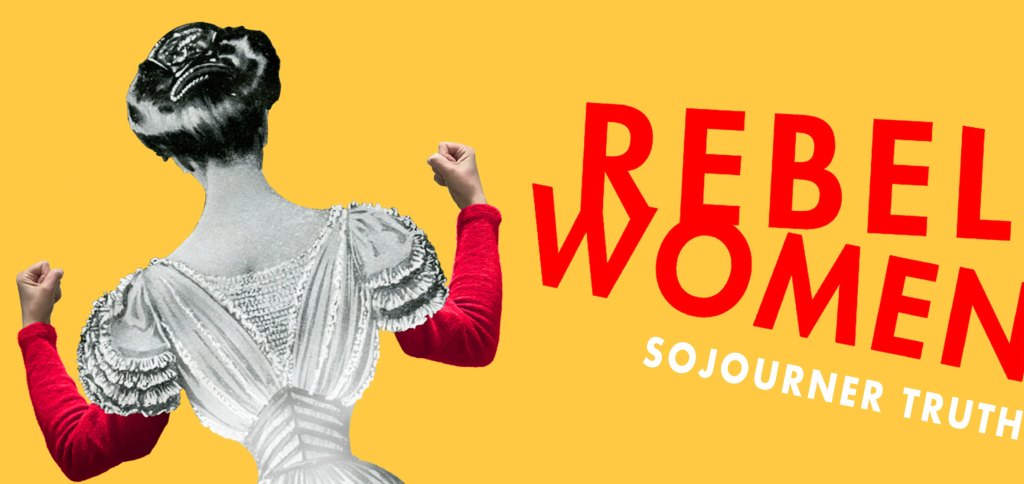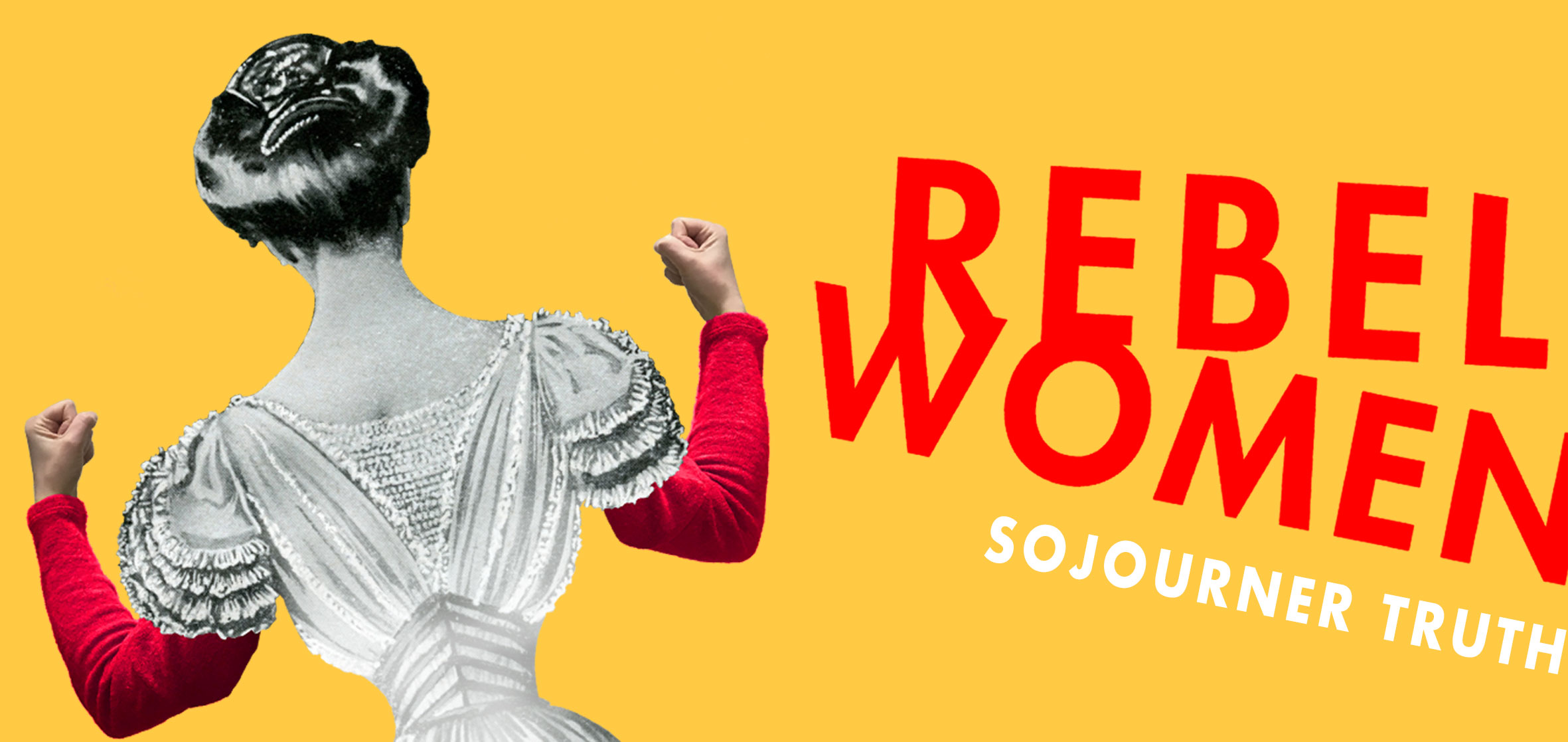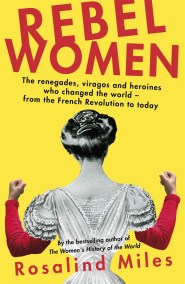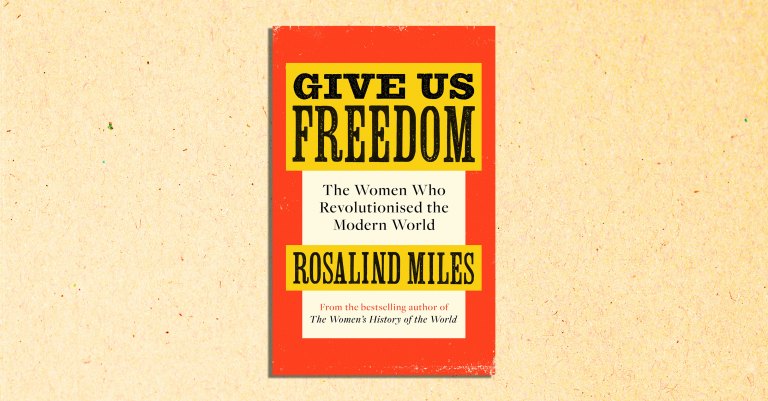Rebel Women, Sojourner Truth


In May of 1836, four enslaved women in Jamaica were brought before the Stipendiary Magistrate for refusing to work in the fields. As mothers of young children (one woman, Eliza Hall, had ten), they were protesting the action of a new overseer, who had suddenly withdrawn the long-established privilege of maternity that exempted them from the hard and dangerous labour of cutting sugar cane. The punishments for their ‘insolence’ escalated from seven days’ solitary confinement in the House of Correction to fourteen days of the same, this time with two spells on the treadmill every day. Add to these penalties the misery of being separated from their children and therefore unable to breastfeed, throw in sweating on the torture of the treadmill with painfully engorged and leaking breasts in the Caribbean heat, and their defiance looks courageous indeed.
Enslavement had been a fact of human society ever since our forebears rose above the primate level. But the political revolutions of the 1800s forced a general questioning of established assumptions, creating one of the cracks in the monolith of male power through which rebel women have always been able to make progress. In Britain, the campaign to ban the slave trade began as early as 1783, and women were prominently involved from the start. Among them was the Irish Quaker Mary Birkett Card, who wrote a lengthy ‘Poem on the African Slave Trade’ when she was only seventeen, addressed ‘To Her own Sex’. Acting together, she argued, all her ‘sisters’ had the power to end the suffering of the slaves by refusing to buy sugar, molasses and rum, since turning a blind eye to the human cost of these luxuries made women guilty of the cruelties too.
Many felt the same. In 1852, a forty-year-old white teacher from Connecticut published a book destined to be the bestselling novel of the nineteenth century, and also its second biggest seller after the Bible – a rich irony, when the world’s most famous attack on slavery went head to head with the very tome that gave divine proof to its defenders that it was the will of God. Uncle Tom’s Cabin lost favour as the struggle against slavery progressed, and its author, Harriet Beecher Stowe, has been unfairly depicted as a racist for her creation of stereotypes like the warm black Mammy, the cute little piccaninny and above all the faithful slave of the novel’s title, Uncle Tom. But in her life Stowe was a courageous and convinced abolitionist, and her radical approach in the novel, presenting her black characters as human beings with feelings, exposed the true horrors of slavery for the first time.
The international success of Uncle Tom’s Cabin is also credited with winning vital support for the North at the onset of the American Civil War. One man at least recognised the pivotal role played by Harriet Beecher Stowe in awakening the world to the evils of slavery and in asserting the human, not financial, value of black lives. Meeting her in 1861 after the war had broken out, the newly elected President Lincoln reportedly greeted Harriet Beecher Stowe with the observation, ‘So this is the little lady who started this great war’.
Stowe undoubtedly turned the tide of popular opinion in America, but she did not do it alone. Women were at the forefront of the struggle, and by the 1830s, female anti-slavery associations had sprung up all over the US. Way ahead of the pack were the Grimké sisters Sarah and Angelina, the first American women to speak out against slavery in a public campaign. The daughters of a powerful South Carolina judge who upheld the subordination of women as strongly as he defended his ownership of slaves, they had plenty to rebel against. Moving to Massachusetts as adults, they joined the local Quaker community and set to work to end slavery, the only white women from the US South ever known to be active in the abolitionist cause.
Their courage was astonishing in an era when malign bigotry, racial hatred and violence could swiftly fall not only on slaves, but on those who questioned slavery too. The Grimké sisters were mobbed, threatened with imprisonment, stoned and, in 1838, driven out of Philadelphia when the building where they had spoken was set on fire. Unsurprisingly, they were also among the first to make the connection between the enslavement of black people and the lack of freedom inflicted on the female half of the population. They pressed for votes for women as fiercely as they campaigned for slaves, and all their lives they showed up at elections and tried to vote, knowing that they would be roughly turned away. Sublimely indifferent to criticism, hostility or even violence, they grew even bolder as they grew older, and both lived long enough to see the fruits of their efforts. ‘We Abolition Women are turning the world upside down’, declared Angelina Grimké with satisfaction as she reviewed their work.
Sarah and Angelina Grimké were quite extraordinary in an era when the vast majority of people held it as an article of faith that slaves were born to endure their sorry lives and should accept the state of ‘natural servitude’ that their white owners insisted was their ‘divine lot’. Yet again and again, defying this powerful propaganda, women in slavery found a way to rebel. The glorious Harriet Tubman first escaped from her Maryland plantation in 1849, then put herself in great danger by returning again and again to conduct around one hundred slaves to freedom in Canada along a secret route with a network of safe houses called the ‘Underground Railroad’. There, as she observed, ‘I was the conductor on the Underground Railroad for eight years and I can say what most conductors can’t, I never run my train off the track and I never lost a passenger’. That may have been because any ‘passengers’ wanting to turn back would catch the sudden gleam of moonlight on the barrel of Tubman’s gun, and feel the shock of cold steel against their necks as she spelled out the alternatives: ‘You’ll be free, or you’ll die a slave!’
And she meant it. Already the fugitives had learned too much about the Railroad to be allowed to live.
Like Tubman’s unforgettable contribution, the life and work of the former slave Sojourner Truth also re-made the modern world. Born to a slave family on an estate north of New York as Isabella Baumfree, she was sold away from her parents and siblings at the age of nine. Sold on, then sold again from childhood, she encountered cruel ill-treatment at every stage. From the age of fourteen, she was owned by a John Dumont, who raped her but still treated her better than his wife did. Sally Dumont harassed and beat the girl with sadistic regularity and is thought to have sexually abused her too. ‘Bella’, as she was known, endured all this until the age of 26, when she walked off the property with her youngest child in her arms, forced to leave behind the older children she had borne after marrying another slave.
From there, her luck turned. She was taken in by a couple, Isaac and Maria van Wagenen, who bought her freedom from Dumont for the sum of $20. She then discovered that Dumont had illegally sold her young son south into Alabama, and the von Wagenens supported her through the long and tortuous legal process of getting him back. This stunning victory made her one of the first black women in US history to go to law against a white man and win. Changing her name to ‘Isabella van Wagenen’ in gratitude was a significant step towards changing her life. During her time with the van Wagenens, a deeply religious couple, she also had a transcendent spiritual experience that formed the basis of an intensely personal and lifelong relationship with God.
Led by her vision, she took to the road in the 1830s as an itinerant preacher, where her previously undiscovered gift for public speaking was immediately recognised. The testimony of former slaves was crucial to the abolition movement, so she was soon bearing first-hand witness to all the iniquities she had suffered and seen. She proved a riveting orator, in demand everywhere. Her travels round America brought her into contact with emerging feminists like Elizabeth Cady Stanton and Susan B. Anthony, both staunch abolitionists. Like them, she understood that the two causes so often seen as separate, the emancipation of slaves and the rights of women, were in fact one and the same, freedom from tyranny for all who were not free.
Alongside the approval she was beginning to enjoy, she attracted constant threats and hostility. One regular insult was that, at six-foot tall and big-boned, she was a man. She never showed fear or refused to speak to an angry crowd. Her steadfast courage and personal authority gave her a remarkable power to quell a dangerous audience: God, she said, had made her ‘tall inside’. She now re-named herself as a ‘Sojourner’, because her stay anywhere would always be brief, and ‘Truth’, as that was the mission given to her by God in one of their mystical communions. Under that name she delivered a speech without notes at the Ohio National Women’s Rights Convention in 1851, this version of which has gone down to history:
That man over there says women need to be helped into carriages and lifted over ditches, and to have the best place everywhere. Nobody ever helps me into carriages and over mud puddles, or gives me any best place, and ain’t I a woman?
Look at me! Look at my arm! I have ploughed and planted and gathered into barns, and no man could head me – and ain’t I a woman?
I could work as much and eat as much as a man – when I could get it – and bear the lash as well. And ain’t I a woman?
I have borne thirteen children, and seen most all sold off into slavery, and when I cried out with my mother’s grief, none but Jesus heard me – and ain’t I a woman?
Sojourner Truth spent the rest of her life serving the cause of freedom, and her work to enlist soldiers for the Union in the US Civil War gained her, like Harriet Beecher Stowe, the thanks and praise of President Abraham Lincoln himself. After her death in 1883, her legacy has been commemorated with numerous statues, citations and awards. In 2009, she became the first black woman to be honoured with a bust in the US Capitol for her services to emancipation, and five years later she appeared on the list of the Smithsonian Institution of the ‘One Hundred Most Significant Americans’. Her faith in women and in the progress of human rights, as expressed in one of her speeches, still has the power to light our way: ‘If the first woman God ever made was strong enough to turn the world upside down all alone, these women together ought to be able to turn it back and get it right side up again!’.







